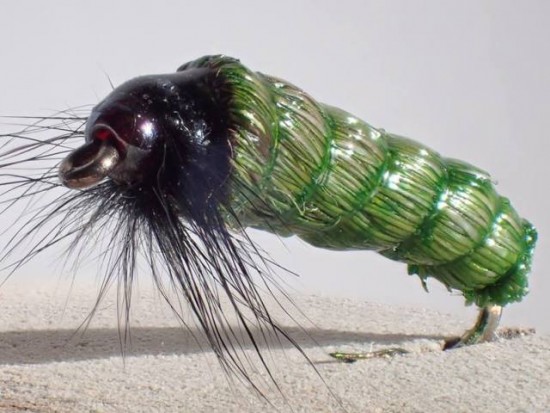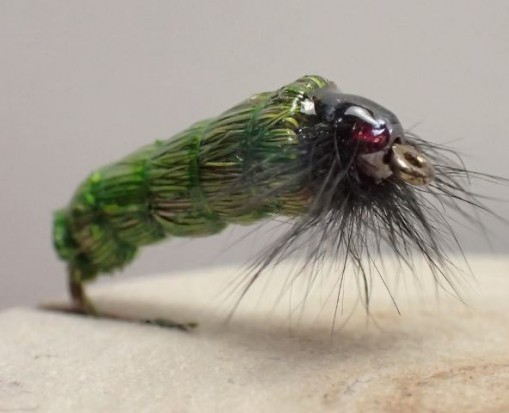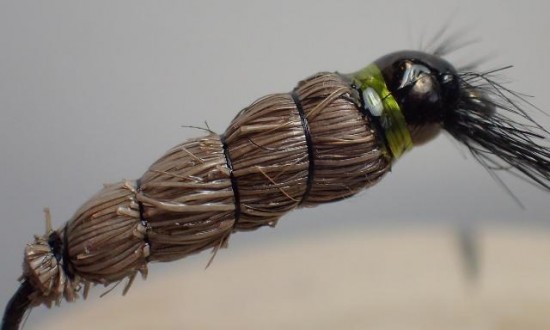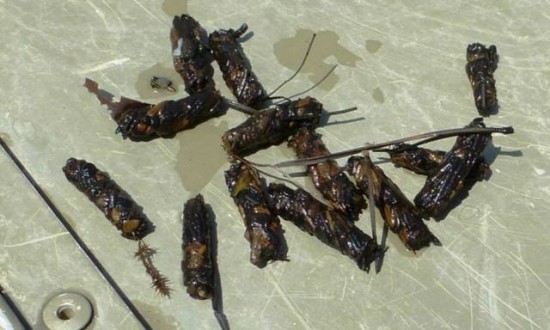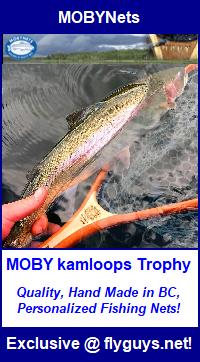This Green Grass Cased Caddis fly pattern is courtesy of James Meyer. A big thanks to James for sharing this innovative caddisfly larva imitation with the guys & gals of flyguys.net! 😀
Green Grass Cased Caddis Fly Pattern …
In all honesty, caddis nymphs are rarely my first choice when choosing flies. I was raised fishing Kamloops’ stillwaters, where I focused my fishing efforts on chironomid, leech, dragonfly nymph, and dry fly techniques. It wasn’t until I moved from the Kamloops area, and began fishing more swiftwaters, that I started to fully appreciate the utility of knowing how, and when to fish caddis nymphs. Imitating a cased caddis always seemed like a silly idea to me. I had never spotted a cased caddis in a throat pump and figured their case must be an excellent deterrent to foraging trout.
My opinion of the cased caddis changed completely after a day on the Kettle River in the Christian Valley. I had spent all morning watching trout swim around in the crystal clear holes and ignore every fly I could put in front of their noses. I had never been so frustrated while fishing! I decided to take a lunch break on a sunny sandbar and hopefully that one magic fly would appear in my box and bring me some luck. I hung my feet in the cool water of the Kettle, snacked on some gas station grub and eyed up the flashes of silver darting underneath the water’s surface. That is when I noticed the gravel – it was moving! My first thought was the gas station in Rock Creek sold me some funky pepperoni, but I soon realized that the entire river bed was covered in huge caddis, cased in fine gravel. The entire riverbed was an undulating mass of cased caddis!
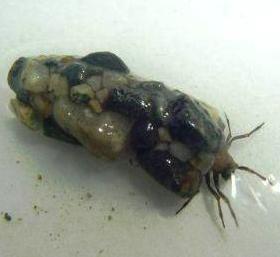 I figured the trout must be focusing on the caddis as forage. It was the only insect I had seen in the waters all day! I didn’t have a cased caddis fly (who would?) and any caddis patterns I had with me were emergers or dries. I dug around in my boxes and found a sz 10 bugger with a body that had a colour similar to the gravel, hacked off the hackle and used a black Sharpie to make a black head. The fly was ugly, but it worked! I pumped the first fish I caught and the throat sample came up empty. I stuck with the fly and managed to hook a couple more. I took one nice bow home for dinner, when I gutted the fish the stomach was packed – PACKED – with huge cased caddis! After that trip I decided to throw some cased caddis patterns in my box. Since then I have had a few days where cased caddis patterns have saved my butt!
I figured the trout must be focusing on the caddis as forage. It was the only insect I had seen in the waters all day! I didn’t have a cased caddis fly (who would?) and any caddis patterns I had with me were emergers or dries. I dug around in my boxes and found a sz 10 bugger with a body that had a colour similar to the gravel, hacked off the hackle and used a black Sharpie to make a black head. The fly was ugly, but it worked! I pumped the first fish I caught and the throat sample came up empty. I stuck with the fly and managed to hook a couple more. I took one nice bow home for dinner, when I gutted the fish the stomach was packed – PACKED – with huge cased caddis! After that trip I decided to throw some cased caddis patterns in my box. Since then I have had a few days where cased caddis patterns have saved my butt!
In swiftwaters I find most cases are comprised of small gravel or rotting organic debris. In stillwaters I have found a lot more variation in the materials used by caddis to make their case. This pattern was originally developed to mimic the small caddis found in one of my favourite lakes during June here in the Northeast. This small caddis makes its case from bright green grasses that grow in the shallows. This species of caddis really can move its big grassy booty, so I went for a case material that would allow the body to bounce and wobble around, instead of dragging along like a heavy gravel case. The deer hair used for the case in this pattern gives the abdomen some buoyancy, which helps keep the hook point out of the lake bottom and allows it to bob up and down when retrieving the fly line. Try tying this fly with a grass green case, rotten leaf brown, black or natural deer hair. I have had luck on all colours.
I fish this pattern in the shallows on a full sink or sink tip line and a 9’ leader & 3’ tippet. Let the fly sink to the lake bottom around grasses, weedbeds, beaver lodges or along the shore where deciduous trees overhang the bank. Use a slow finger retrieve with the occasional twitch. Hits are subtle – I think the trout suck up the caddis.
Green Grass Cased Caddis Fly | Materials List:
- Hook: 2XL Nymph (sz 16-8)
- Thread: Black 10/0 Veevus & waxed dental floss
- Beads: black glass seed & 1/8” black tungsten
- Legs: Black rabbit fur
- Thorax (optional): Caddis green stretch floss
- Abdomen (case): Deer hair & .010 or .020 lead wire
- Case Reinforcement (optional): UV resin or Sally Hansen
* if you skip the thorax just tie the case up so just the head peeks out. 😉
Green Grass Cased Caddis Fly | Tying Steps:
- Pinch barb, slide seed bead then tungsten bead onto hook.
- Start thread between the two beads and make a dubbing loop.
- Spin a small amount of rabbit fur in the loop to form legs. Wrap loop 1-2 times around shank and whip finish.
- Start thread behind tungsten bead. Wrap lead around about 1/5 of abdomen shank starting behind the beads. Use the lead to form a rough taper between beads and shank.
- If desired, tie in thorax material and wrap up the taper and over ½ of the tungsten bead and back down the taper to the bare shank and tie off.
- Stack a clump of deer hair, a little less than the diameter of a pencil.
- Tie in the deer hair by the tips behind the abdomen taper, with the ends facing the hook eye. Spin the hair evenly around the shank.
- Wrap the thread over the deer hair, up the taper and back down towards the hook bend.
- Tie in the dental floss and wrap it over the deer hair up the abdomen to the head. Make the floss wraps very tight – especially the last couple at the head. Wrap floss back down body and tie off near hook bend.
- Use a drinking straw with a slightly larger diameter than your tungsten bead and push it over the head, pushing the deer hair back over the body. Slide the straw down the body almost to the hook bend.
- Wrap thread around the ends of the deer hair, securing them in place. Slide off the straw.
- Wrap thread back towards the head as a rib.
- Whip finish just in front of the case. Watch your thread bulk!
- Trim up any loose deer hair bits on the case.
- Use resin or nail polish on thread wraps.
- Pull legs to the sides and bottom of the hook, put a drop of UV resin between the top of the beads to make a single head.
But wait there’s more …….
Green Grass Cased Caddis Fly | The Video:
That’s all folks, tie some up and go fishing!
*** if you’re interested in custom tied, time tested & proven effective BC Interior fly patterns, but would rather buy than tie, please Contact us for details!
*** for more effective BC stillwater fly fishing patterns be sure to check out all of flies on our BCs best fly patterns index page!
Like our stuff? Subscribe by ![]() Feed or
Feed or ![]() Email
Email .jpg)

